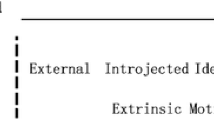Abstract
The underlying “architecture of the decision to pursue a degree in psychology was quantified using the Method of Sorting technique to identifying the critical issues necessary to make this choice. Multidimentsional scaling procedures were employed to construct a three-dimensional map representing the relationships between reasons for selecting psychology as a major. Freshman and senior psychology majors (N = 165) from a regional university and a large research-based institution rated the relative importance of items in their decision-making process. Hierarchical clustering procedures revealed seven different groups of students. Although significant differences associated with class standing were not found, institutional affiliation did influence cluster composition. Reflecting local emphases, students at the regional institution had a greater interest in Counseling Psychology, whereas those at the research-based school focused on Clinical Psychology. This semantic map and the associated item clusters arising from psychology student data provides an empirical basis for, amongst other things, course selection, faculty-initiated program design or revision, strategic niche marketing, and student retention.
Similar content being viewed by others
References
American Psychological Association (2001). Divisions of the American Psychological Association by Number and Name. Retrieved on April 3, 2003 from http://www.apa.org/about/division.html/
J. Arnett (2000) ArticleTitleEmerging adulthood: A theory of development from the late teens through the twenties. American Psychologist 55 469–480 Occurrence Handle10.1037//0003-066X.55.5.469 Occurrence Handle10842426
J. Atkinson (1964) An Introduction to Motivation Van Nostrand Reinhold New York
D. Bimler J. Kirkland (1998) ArticleTitlePerceptual modeling of product similarities using sorting data Marketing Bulletin 9 16–27
D. Bimler J. Kirkland (2001) ArticleTitleSchool truants and truancy motivation sorted out with multidimensional scaling. Journal of Adolescent Research 16 75–102
D. Bimler J. Kirkland (2003) ArticleTitleSmoke and mirrors: Mapping the dimensions of a ‘cigarette space’ Quality & Quantity 37 377–391
J. Block (1978) The Q-Sort Method in Personality Assessment and Psychological Research Consulting Psychologists Press Palo Alto, CA
K. Cross M. Steadman (1996) Classroom Research: Implementing the Scholarship of Teaching Jossey-Bass Publishers SanFrancisco, CA
W. Dixon M. Brown L. Engleman R. Jennrich (1990) BMDP \(\circledR\) Statistical Software Manual University of California Press Berkeley, CA
J. Eccles (1983) Expectancies,values,and academic bahaviors J. Spence (Eds) Achievement and Achievement Motives Freeman New York 75–146
N. Feather (1982) Human values and the prediction of action: An expectancy-valence analysis N. Feather (Eds) Expectations and Actions: Expectancy-Value Models in Psychology. Erlbaum Hillsdale, NJ
N. Feather (1988) ArticleTitleValues, valences, and course enrollment: Testing the role of personal values within an expectancy-value framework Journal of Educational Psychology 69 579–585
B. Hofer (2002) Motivation in the college classroom W. McKeachie (Eds) Teaching Tips: Strategies Research, and Theory for college and University Teachers EditionNumber11th edn. Houghton Mifflin Boston 118–127
T. Mayne J. Norcross M. Sayette (1994) ArticleTitleAdmission requirements, acceptance rates, and financial assistance in clinical psychology programs American Psychologist 49 805–811 Occurrence Handle10.1037/0003-066X.49.9.806
T. Mayne J. Norcross M. Sayette (2000) Insider’s Guide to Graduate Programs in Clinical and Counselling Psychology Guilford New York
W. McKeachie (1994) Teaching Tips: Strategies, Research and Theory for College and University Teachers EditionNumber9th edn. Heath Lexington, MA
W. McKeachie (2002) Teaching Tips: Strategies, Research and Theory for College and University Teachers EditionNumber11th edn. Houghton Mifflin Boston, MA
S. Merriam R. Caffarella (1991) Learning in America: A Comprehensive Guide Jossey-Bass San Francisco
J. Norcross J. Hanych R. Terranova (1996) ArticleTitleGraduate study in psychology: 1992–1993 American Psychologist 51 631–643 Occurrence Handle10.1037/0003-066X.51.6.631
SAS Institute, Inc. (1989). SAS \(\circledR\) User’s Guide: Statistics, Version 5. Cary, NC
Salon Obituary (2000). Saul Steinber: Retrieved January 21, 2003, from http://www.salon.com/people/obit/1999/05/13/steinberg/
W. Trochim R. Linton (1986) ArticleTitleConceptualization for evaluation and planning Evaluation and Program Planning 9 289–308 Occurrence Handle10.1016/0149-7189(86)90044-3 Occurrence Handle10301179
A. Wigfield J. Eccles (1992) ArticleTitleThe development of achievement task values: A theoretical analysis Developmental Review 12 265–310 Occurrence Handle10.1016/0273-2297(92)90011-P
Author information
Authors and Affiliations
Corresponding author
Rights and permissions
About this article
Cite this article
Stewart, R., Hill, K., Stewart, J. et al. Why I am a Psychology Major: An Empirical Analysis of Student Motivations. Qual Quant 39, 687–709 (2005). https://doi.org/10.1007/s11135-005-4484-9
Issue Date:
DOI: https://doi.org/10.1007/s11135-005-4484-9




